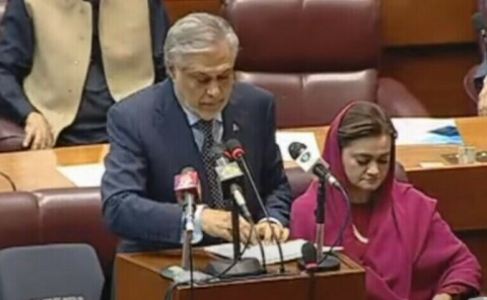Finance Minister Ishaq Dar presents budget for FY24 in National Assembly

ISLAMABAD, JUN 9: Finance Minister Ishaq Dar is presenting the budget for fiscal year 2023-24 (FY24) on the floor of the National Assembly.
The NA session began with recitation of the Holy Quran followed by the national anthem. Prime Minister Shehbaz Sharif is also in attendance in a house without an opposition. The budget is expected to sail through in the absence of opposing voices.
Dar began his speech recounting the achievements of the PML-N’s previous government under Nawaz Sharif. He said the country was doing well on all accounts, with inflation in single digits and GDP growth of 6 per cent.
He then went on to blame Pakistan’s current economic crisis on the PTI government, which took over the reigns in 2018.
The government is expected to walk a tight rope in this budget as it looks to meet the requirements of the International Monetary Fund (IMF) as well as provide some relief to the public in what is an election year.
Getting the IMF on board is critical as the risk of default on sovereign debt is rising, with the economy creaking under twin deficits and record high inflation, which has further dented the popularity of Prime Minister Shehbaz Sharif’s coalition.
The coalition government is hoping to persuade the IMF to unlock at least some of the $2.5bn left in a $6.5bn programme that Pakistan entered in 2019 and which expires at the end of this month.
The country missed almost all of its economic targets set in the last budget, most notably its growth target, which was initially set at 5pc, revised down to 2pc earlier this year. Growth is now projected to be just 0.29pc for the fiscal year ending June 30.
Foreign exchange reserves have dipped below $4bn, according to data released by the State Bank of Pakistan (SBP) on Thursday, enough to cover barely a month of imports.
The government has no fiscal space to introduce popular measures that will win it votes or a stimulus to spur flagging economic activity, with limited avenues for raising revenue in the short term and domestic and international debt obligations continuing to mount.
Related News

16 soldiers martyred, 8 militants killed in South Waziristan attack
Rawalpindi, 21 Dec /DNA/ – On night 20-21 December 2024, a group of Khwarij attemptedRead More

Terming military courts decisions ‘illegal’, PTI says ready for talks with govt
ISLAMABAD, DEC 21: The Pakistan Tehreek-e-Insaf (PTI) on Saturday denounced the sentencing of accused involvedRead More


Comments are Closed